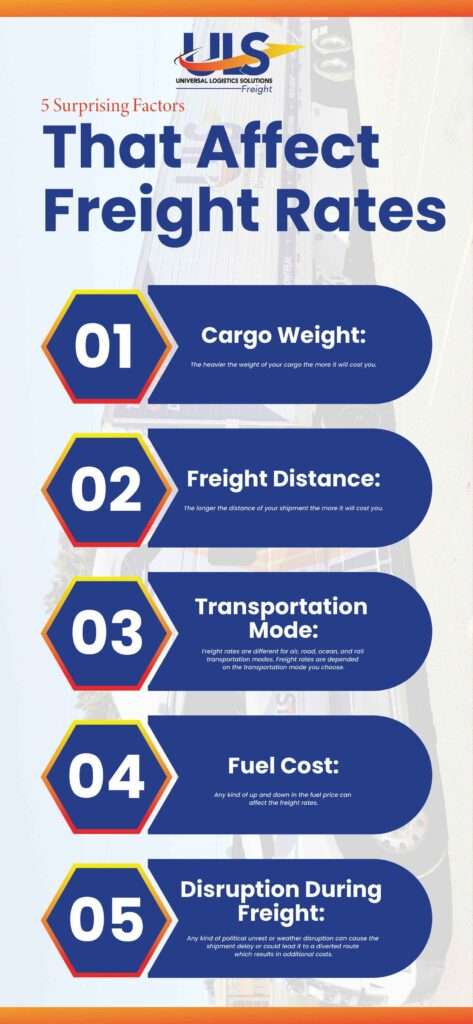When it comes to shipping goods, one of the most important considerations is the freight rate, the cost associated with transporting goods from one point to another.
But what many shippers don’t know is that there are many unexpected factors that can affect the freight rate.
However, what many people don’t realize is that there are several factors that affect freight rates. From the time of year to fuel surcharges, these factors can have a surprising effect on your shipping costs.
According to a Wikipedia report, freight rates are actually the cost of transporting goods from one place to another place and the freight rates depend on several factors which include cargo weight, delivery destination distance, the season in which goods are transported, disruption while transporting, fuel cost, demand for freight, etc.
In this blog post, we will take a deeper look at 5 of the most surprising factors that affect freight rates in 2023.
5 Surprising Factors That Affect Freight Rates In 2023:
Here are the top 5 surprising factors that affect the freight rates in 2023. Let’s discuss all the factors one by one.

1. Cargo Weight:
One of the major factors that affect freight rates is cargo weight. When shipping goods, the heavier they are, the more they will cost.
This is because heavier loads require additional fuel to move them from one location to another.
Thus, a higher freight rate is charged to offset the increased fuel costs incurred by the carrier.
As a shipper, you should always ensure that your goods are packed in the most efficient way possible to reduce their weight and, in turn, the freight rate.
2. Freight Distance:
Another influential factor that affects the freight rates is the distance of the shipment.
The farther the shipment has to travel, the more expensive it is to ship.
This is because carriers charge more for long hauls than short hauls due to the additional fuel and labor costs involved.
Additionally, carriers may need to hire subcontractors to complete longer trips.
All of these additional costs can add up quickly, leading to higher freight rates for longer trips.
Understanding this factor when making shipping decisions can help keep costs down and help you make the best choices for your business.
3. Freight Transportation Mode:
Freight transportation modes also affect freight rates. Different modes, such as air, rail, truck, and ship, can have different costs associated with them, depending on the size and weight of the cargo being shipped.
As an example, air transport is generally more expensive than truck transport due to its faster delivery times.
On the other hand, sea freight may be more economical in some cases because of its larger capacity and slower delivery times.
By understanding these various transportation modes and the costs associated with them, businesses can better determine which mode is best suited to their needs and budget.
4. Fuel Cost:
Fuel is one of the most important factors that affect freight rates. The cost of fuel affects both transportation and storage costs.
Fuel is an inevitable part of the freight industry, and any fluctuation in its price can have a direct impact on freight rates.
With fuel prices constantly on the rise, shippers must be mindful of this factor when considering their freight rates.
Fuel costs are determined by a variety of factors, including geopolitical tensions, natural disasters, and market forces.
With fuel being so unpredictable, it’s important to always be aware of how it could impact your freight rate.
Taking into account fuel costs is a key factor when determining your freight rates.
5. Disruption During Freight:
Disruptions during freight can be a major factor in determining the cost of shipping goods. Disruptions can come from a variety of sources, such as weather, political unrest, and other circumstances that are out of the shipper’s control.
Depending on the severity of the disruption, it could cause the shipment to be delayed, which would result in additional costs for the shipper.
Furthermore, if the disruption is severe enough, it could lead to cargo being diverted to a different route, resulting in higher transportation costs.
For example, if an unforeseen storm prevents vessels from entering certain ports, cargo may need to be diverted to another port or shipped by air instead.
This could significantly increase the cost of shipping. Thus, when estimating the cost of shipping goods, it’s important to factor in potential disruptions and the costs associated with them.
Final Verdict:
When it comes to determining the cost of freight there are several factors that influence the cost. These include cargo weight, freight distance, transportation mode, fuel cost, and disruptions during freight.
It is important to understand each of these factors in order to make sure you are getting the best rate for your freight shipping needs.
By taking the time to research all of these factors, you can make an informed decision about the best rate for your shipment.

